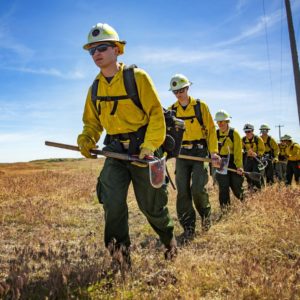 Close to 45 million homes currently reside within the wildland urban interface (WUI). With worsening weather patterns and extended drought conditions, wildland fires continue to be a rapidly growing threat year after year. The wildfires in California during 2020 are just one example of how we’re seeing fires evolve with frequency and intensity, while the limits of wildland firefighting are being pushed to the brink.
Close to 45 million homes currently reside within the wildland urban interface (WUI). With worsening weather patterns and extended drought conditions, wildland fires continue to be a rapidly growing threat year after year. The wildfires in California during 2020 are just one example of how we’re seeing fires evolve with frequency and intensity, while the limits of wildland firefighting are being pushed to the brink.
Over the last decade alone, fire seasons in the United States have increased by two and a half months. Not only that, the average area scorched by fires in the WUI has doubled in the last three decades to nearly seven million acres per year. This figure is only expected to grow. Wildland firefighting is unpredictable, dangerous and physically exhausting. That makes finding solutions that increase capacity while significantly reducing maintenance and manpower not only a good idea but a critical necessity.
When Lives and Structures Are at Stake Effective Tools Are Key
Firefighters navigating on foot through dangerous terrain have to make split-second decisions at every turn. That makes having durable, effective, and reliable tools critical. They provide protection, confidence, and peace of mind.
Compressed Air Foam Systems (CAFS) can provide all that and more. Here are some of the myriad benefits of CAFS:
- Faster knockdown and attack times
- Fire control using fewer gallons of water
- Increased exposure protection
- Reduce need for mop-up and overhaul
- Reduces firefighter fatigue
- Prevent and control spot fires outside the burn area
- Pretreat adjacent exposures
Powerful Wildland Firefighting in a Compact Package
The Macaw® Backpack is a CAFS that combines reliability with impressive fire extinguishing properties in a compact package. This system is a game-changer and a must-have in your firefighting arsenal.
The Macaw® converts 5 gallons of water and firefighting foam up to 175 gallons of finished foam through Intelagard’s patented Enviroshield® technology. It deploys a tight and structured uniform stream of bubbles to disrupt the thermal layer and suffocate fire vapors during a direct attack. Once the unit runs dry, it can be refilled from a stream, creek, pond, pool, or lake in a snap (even dirty and brackish water with debris up to 1/4th inch will work).
It’s also an ideal system for indirect attacks and mop-up. Lay down wet lines, control backburn, and wet the duff with precision and ease. Applied ahead of a fire it can be used to form a moist fire break in brush or grass, or it can be applied to pretreat structures from the ignition as a fire passes over.
The Macaw® has been proven to be exceptionally effective in protecting exposed structures and vegetation in parts of the WUI where water supply can be critically limited. The Enviroshield® Technology creates an insulating layer of foam that will adhere to vertical and horizontal surfaces such as walls and roofs to create a durable moist barrier.
The Intelagard Advantage
Intelagard has invested thirty years into the research, design, and manufacturing of innovative, military-grade Compressed Air Foam Systems for firefighters and first responders working in the toughest conditions.
Source: https://agupubs.onlinelibrary.wiley.com/doi/full/10.1029/2019EF001210
Source: https://www.nfpa.org/Public-Education/Fire-causes-and-risks/Wildfire

